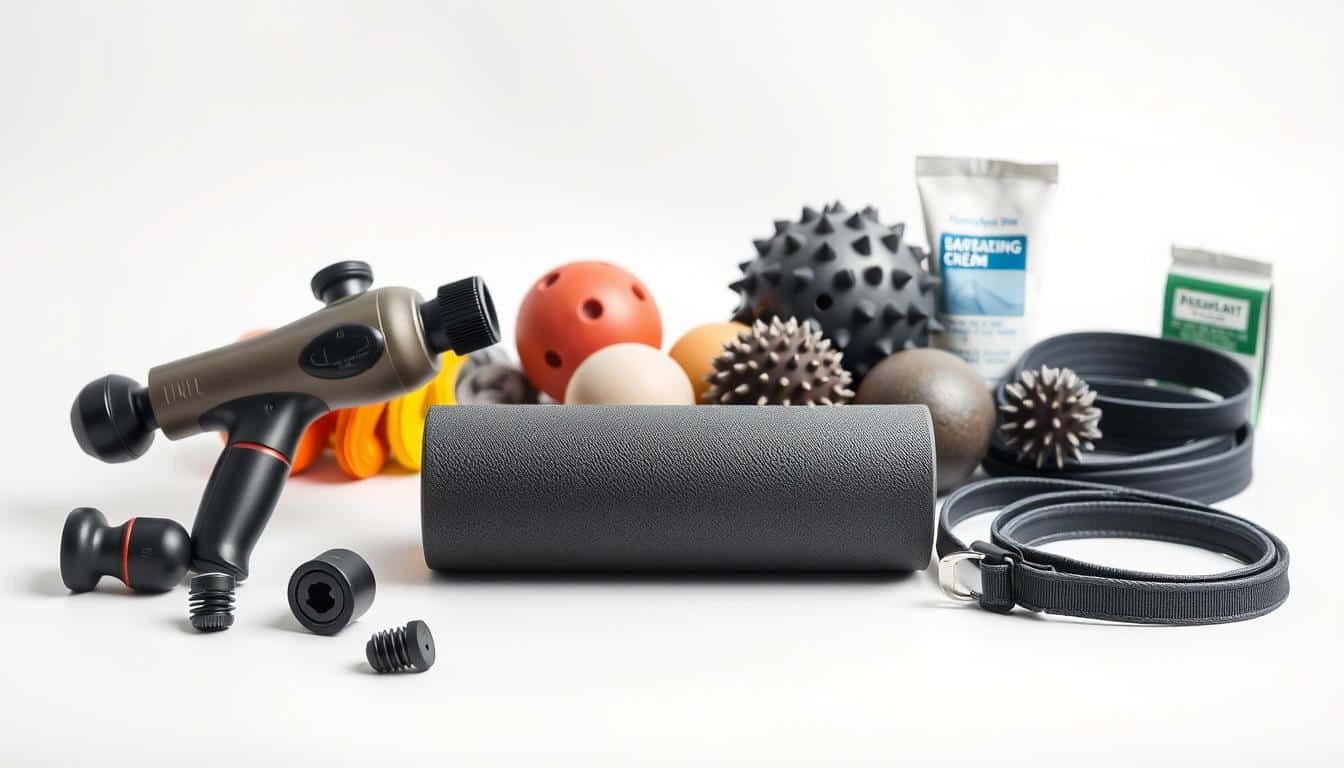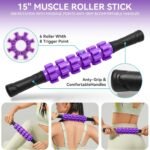Did you know that 1 in 10 people will experience heel pain severe enough to disrupt their daily routines? For years, I dismissed my discomfort as normal fatigue—until every step felt like walking on thumbtacks. The thick ligament supporting my foot’s arch had become inflamed, turning simple tasks into exhausting challenges.
Traditional methods like stretching and ice packs offered temporary comfort but never addressed the root issue. Frustration grew as morning stiffness lingered longer, and my favorite runs became impossible. That’s when I discovered percussion therapy—a game-changer that finally delivered lasting results.
This approach didn’t just soothe surface-level aches. It penetrated deep into tight muscles and connective tissues, restoring flexibility I thought was gone forever. What started as a desperate experiment became my daily ritual for reclaiming pain-free movement.
Key Takeaways
- Heel pain affects millions, often worsening without proper care
- Standard treatments may not resolve chronic foot inflammation
- Targeted pressure breaks down tension in affected areas
- Consistent use improves mobility faster than passive methods
- Personal experimentation revealed unexpected benefits
My Journey to Finding Relief
Waking up felt like stepping on glass every morning. What began as minor discomfort evolved into relentless throbbing that reshaped my daily life. Simple joys like walking barefoot or chasing my dog became battles against invisible knives slicing through my heel.
Recognizing the Early Signs of Plantar Fasciitis
That first sharp twinge after getting out of bed was my red flag. Within weeks, the ache spread from my heel to the entire sole, turning ordinary tasks into endurance tests. Climbing stairs? Forget it. Standing while cooking? Pure agony.
Why I Decided to Try a Massage Gun
Traditional fixes failed me. Ice packs melted before providing real relief, and stretching only offered fleeting comfort. Desperation drove me to research alternative solutions. That’s when I found percussion therapy guides explaining how targeted pressure could break down stubborn tension.
| Treatment | Effectiveness | Convenience |
|---|---|---|
| Ice Packs | Temporary | High maintenance |
| OTC Medications | Masked symptoms | Short-term fix |
| Percussion Device | Deep relief | On-demand use |
User testimonials convinced me this wasn’t just another gimmick. People described reclaiming their mobility through consistent use—exactly what I needed. The ability to treat flare-ups immediately, without waiting for clinic appointments, sealed my decision.
Understanding Plantar Fasciitis and Its Impact

The human foot contains 26 bones and a network of tissues, but one band caused all my problems. My journey to recovery began when I finally grasped how this critical structure functions—and why mine had rebelled.
What Is This Persistent Foot Condition?
I discovered my pain stemmed from a thick band tissue stretching from heel to toes. Doctors call it the plantar fascia—your body’s natural shock absorber. When overused, this resilient ligament develops microtears, leading to stubborn inflammation.
Triggers and Warning Signals
Mornings became my enemy. That first step out of bed felt like shards digging into my heel. The ache would ease slightly after walking but returned with vengeance after sitting. Prolonged standing or climbing stairs? Pure torture.
I learned this cycle had a name: the “post-static dyskinesia” effect. Overnight, damaged tissues tightened. Morning movement stretched them abruptly—like snapping a rubber band. Each day repeated the damage, creating a spiral of discomfort.
My research revealed surprising triggers. Hard surfaces, unsupportive shoes, and even tight calf muscles contributed. Understanding these factors helped me modify daily habits while seeking real solutions.
Massage Gun Plantar Fasciitis: Targeted Relief for Heel Pain
Modern recovery tools have rewritten what’s possible for stubborn foot pain. I realized this when rapid pulses from a percussive device began dissolving tension that months of stretching couldn’t touch.
How Percussion Therapy Works for Deep Tissue Relief
The magic lies in mechanical waves traveling through tissue layers. Each pulse acts like a microscopic jackhammer, loosening scar tissue and adhesions binding the plantar fascia. Unlike surface-level rubs, this reaches the root cause of stiffness.
My device’s rapid thrumming did more than relax muscles. It triggered a biological response—increased oxygen delivery to damaged areas. Studies show this process accelerates healing by flushing out inflammatory markers trapped in tight tissues.
I noticed changes within days. Morning steps felt less jarring as restricted fascia regained elasticity. The secret? Consistent sessions stimulated cellular repair while preventing new scar tissue formation. It wasn’t just pain management—it was tissue remodeling.
Targeted treatment also addressed compensatory strain in calves and arches. By releasing neighboring muscles, pressure lifted from the inflamed band. This holistic approach kept discomfort from migrating to other areas.
How I Use the Massage Gun: A Step-by-Step Guide

Effective recovery hinges on technique, not brute force. Through trial and error, I perfected an approach that transformed my daily routine from painful to productive.
Preparing for the Therapy Session
Clean feet and proper positioning make all the difference. I sit with my leg elevated on a stool or lie flat with a pillow under my knee. This exposes the arch fully while keeping muscles relaxed.
I always wipe my skin and device head first. Dirt or lotion residue can reduce effectiveness. The right mindset matters too—I dedicate 10 uninterrupted minutes to focus solely on recovery.
Selecting the Right Tools and Intensity
The small round attachment stays on my device 90% of the time. Its broad surface distributes pulses evenly across sensitive tissues. For stubborn knots near the heel, I switch to the bullet-shaped tip.
Three golden rules guide my sessions:
- Start low: Level 1 intensity for initial passes
- Move slow: 1 inch per second along the arch
- Listen closely: Discomfort means easing pressure
I begin at the arch’s highest point, gliding toward the heel in straight lines. Thirty seconds per zone prevents overstimulation. If tension persists, I increase speed slightly—never force deeper penetration.
Maximizing Benefits While Avoiding Pitfalls

Timing proved crucial in my recovery journey. Through careful experimentation, I uncovered strategies that amplified results while sidestepping setbacks. Balancing intensity with restraint became my formula for sustainable progress.
Optimal Duration, Pressure, and Frequency
Short sessions delivered better outcomes than marathon treatments. I limited each foot to 90 seconds maximum, focusing on tender zones near the heel. Morning sessions eased stiffness, while evening applications improved circulation before sleep.
Consistency trumped aggression. Using the device twice daily at low intensity maintained tissue responsiveness without triggering flare-ups. Gentle pulsing pressure that felt like deep kneading—never sharp jabs—kept inflammation in check.
Common Mistakes to Avoid During Use
Early on, I nearly damaged sensitive nerves by targeting my ankle. Now I steer clear of bony areas entirely. The posterior tibial nerve zone remains strictly off-limits—a lesson learned through temporary tingling that faded with adjusted technique.
Pain signals immediate cessation. Unlike soreness from effective therapy, sharp discomfort indicates improper pressure setting or placement. I track responses in a journal, adjusting angles and attachments until movements feel soothing rather than stressful.
Rushing proves counterproductive. Slow, deliberate strokes along the arch yield deeper release than frantic rubbing. Patience transformed my approach—healing happens through cumulative care, not instant fixes.
Combining Calf and Foot Massage for Complete Relief
The real breakthrough came when I connected the dots between two seemingly separate areas. Tightness in my lower legs wasn’t just a minor annoyance—it directly fueled the fire beneath my heel. By addressing both zones, I unlocked relief that single-target approaches couldn’t match.
Improving Blood Flow and Reducing Inflammation
Focusing solely on my arch felt like patching a leaky roof during a storm. I discovered the gastrocnemius and soleus muscles act as tension reservoirs. When overworked, they pull the Achilles tendon taut, straining the plantar fascia. Releasing these tissues became my priority through rhythmic compression along the calf’s length.
My routine starts with broad, sweeping motions across the meaty upper calf. This primes sluggish capillaries, flushing out metabolic debris that contributes to stiffness. Within days, I noticed reduced morning swelling—a sign of improved nutrient delivery to damaged tissues.
Integrative Techniques for Better Circulation
Sequencing matters. I spend 2-3 minutes warming up calf muscles before touching my foot. This “proximal-to-distal” approach follows the body’s natural fluid dynamics, much like proper leg massage techniques recommend. The difference? Tension releases more completely when addressed in logical chains.
Key strategies I follow:
- Alternating between flat and bullet-shaped attachments for muscle depth variations
- Maintaining continuous motion to prevent bruising sensitive tissues
- Tracking session durations to avoid overstimulating neural pathways
This dual-zone strategy transformed my recovery. By treating the calf-foot system as interconnected partners, I achieved lasting mobility that isolated treatments never provided.
Conclusion
Reclaiming my freedom from chronic foot issues required more than temporary fixes—it demanded a strategic approach. The percussion device became my ally in tackling stubborn inflammation that traditional methods couldn’t resolve. Its rapid pulses didn’t just mask discomfort; they rewired my recovery process at the cellular level.
Consistent use of the massage gun taught me that real healing happens when we address both symptoms and sources. By improving blood flow to damaged tissues and breaking down adhesions, this approach restored flexibility I’d lost to years of compensation patterns. Morning routines transformed from painful shuffles to confident strides.
For those managing plantar fasciitis, the right tools can rewrite your recovery story. Targeted therapy sessions helped me maintain mobility gains that outlast any quick fix. What began as an experiment now serves as my blueprint for lasting foot health—proof that innovation paired with patience creates pathways others might label impossible.
Your first pain-free step could be closer than you think.












